Performance Introduction
We'll be looking at performance using a number of different applications which I'll discuss shortly and there are some changes to my usual test bed which I'll also cover.Software wise, the Hexus benchmark suite is changing and as we formally choose our test applications, there will be a short state of flux as some regular Hexus benchmarks disappear and some new ones come in to take their place. In this review, POVRay says farewell to make room for the Comanche 4 Demo from Novalogic that helpfully includes some nifty benchmark features to make it easy on the reviewer!
Tarinder has paved the way for the full benchmark suite to take effect shortly with his media work with Xmpeg and LAME in recent weeks, however they wont make an appearance until my next motherboard review after this AT7. Bear with us as we obtain parity in our benchmarks!
Hardware wise, I say a fond farewell to my trusty Ti500 which has gone to a new home. In its place, a Ti4400 from MSI that I reviewed recently and that will spend the next few months as the gfx card basis in my review system (many thanks to MSI for the card!). In the future, new Hexus motherboard reviews, from myself and the other core reviewers, will also feature Ti4400's. Otherwise, everthing else is the same as before.
Let's take a look at the test system before we discuss the benchmarks and the performance angles we'll look at.
- ABIT AT7 Socket A DDR VIA KT333 Motherboard
- AMD Athlon XP1500+ Processor (1.33GHz, 10 x 133)
- 1 x 256Mb Samsung PC2700 DDR Memory Module (CAS2)
- Microstar GeForce4 Ti4400 128MB
- Adaptec 39160 PCI SCSI Dual Channel U160 controller
- 2 x 73Gb Seagate Cheetah U160 10,000rpm SCSI disks
- Plextor 12/10/32S SCSI CDRW
- Pioneer 6x Slot-load SCSI DVD
- Windows XP Professional Build 2600.xpclient.010817-1148 (Microsoft)
- DetonatorXP 28.80 NVIDIA drivers (NVIDIA)
- Aquamark v2.3 (Massive)
- Quake3 v1.30 (iD Software)
- Comanche 4 Demo (Novalogic)
- 3DMark 2001 Professional Second Edition (Mad Onion)
- SiSoftware Sandra v2002.2.8.64 (SiSoftware)
- Serious Sam: The Second Encounter Demo (Croteam)
I'll be comparing to the EPoX 8K3A, another VIA KT333 solution in the graphs with some discussion on the results. ABIT, famous for their performance boards will be hoping to come out victorious. Being a KT333 board, the numbers were run in synchronous and asynchronous mode at 133MHz host clock using the test processor. We'll discuss the performance implications for each mode if needed.
So to start with, the Sandra Memory Bandwidth Benchmark. I dispense with the CPU Arithmetic and CPU Multimedia Benchmark's these days since the results hardly change from motherboard to motherboard. Rest assured the numbers were run and they looked fine for the host processor.
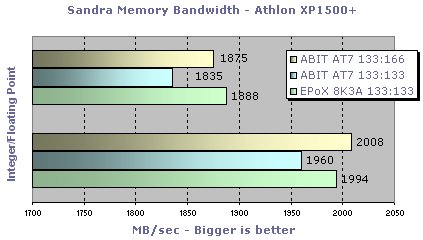
The top section of the graph is the floating point result using buffering and multimedia instruction sets where possible (MMX in this case). While the EPoX beats the AT7 in this part of the test, regardless of the AT7 running its memory clock at 133 or 166MHz, the difference is less than 3%, undetectable in the real world. Regardless, in the floating point test, the AT7 takes a back seat to the EPoX.
In the integer test, the tables are turned with the AT7 in async mode taking the lead but again the difference is minute, this time less than 1% which is a reasonable margin of error (although repeatable). Identical performance from both KT333 solutions with the AT7 giving no quarter to it's leaner opponent.
Round 2 brings the first of our game based benchmarks to the table, 3DMark 2001 SE. As we've remarked many times before, 3DMark 2001 SE is a full system benchmark which stresses all parts of the system via the various game tests.
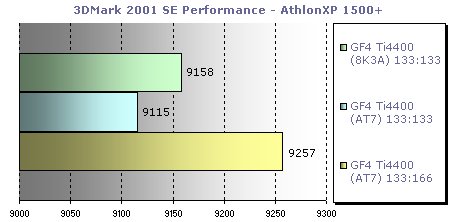
Less than a 1% deviance seperates both AT7 and 8K3A in synchronous 133:133 mode. Identical performance for all real world conclusions that we can draw. Asynchronous mode brings us a rough 100 point increase in exchange for the increased memory bandwidth, giving the host processor that little bit more head room to work in. It's worth remarking that the Ti4400 performs excellently on KT333 out of the box and that AT7 has the performance to feed it, albeit powered by my little XP1500.
Again, a tied round between EPoX and ABIT as far as overall real world performance is concerned which is to be expected when both boards feature the same chipset, same graphics card and the same drivers.
Round 3 and we have Quake3. Getting long in the tooth but still a valid benchmark which can also give you a very rough idea of how recent Q3 engined games will perform such as Medal Of Honour: Allied Assault and Jedi Knight 2. It's a very rough idea however!
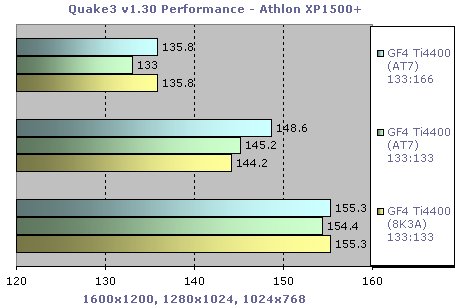
Being fairly old, OpenGL based which NVIDIA cards have classically performed well in, and unreliant on a super fast system for good performance, the test bed with AT7 should walk this test with ease.
Very little in it with some small disparities to be seen. The AT7 in async mode takes the spoils in 1280x1024 resolution but otherwise it's evenly matched. At 133MHz host clock and async mode, the performance advantage from running the memory bus at 166MHz is largely negated by slow CPU speed, low host clock and increased memory latency. The benefit is tangible, just not massive. Tied performance with the EPoX yet again in the real world.
Round 4 brings a favourite of mine to the table, Serious Sam 2: The Second Encounter. SS2:TSE is much like 3DMark 2001 in that it stresses your system all round and doesn't focus on stressing one component too much. The Valley Of The Jaguar demo is our weapon of choice here.
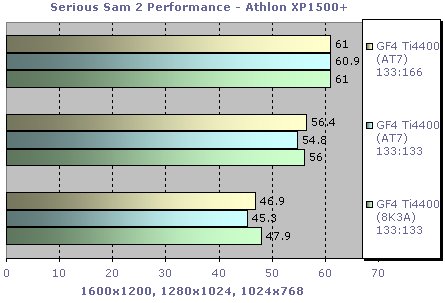
Can you see a pattern emerging? With less than 3% deviation between EPoX and AT7 here across any of the test resolutions, we have yet another case of a drawn round in the fight between the two. The results really are too close to call an outright winner with 3% deviation meaning very very little in the real world. Indeed, it's a performance delta that can only be identified using benchmarks such as SS2:TSE.
Round 5 and Aquamark steps up to be knocked about. Requiring a hardware DX8 class accelerator for maximum performance, Aquamark is a good test of graphics performance. The AT7 and Ti4400 should perform very well and the AT7 should do well versus the 8K3A.
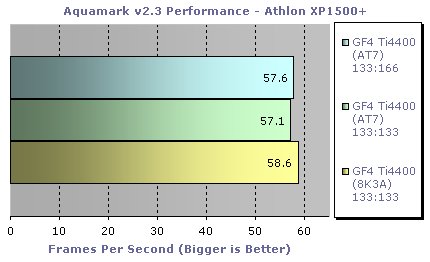
The EPoX wins but not that you'd notice. Again, a 2% performance delta means that real world performance is identical. Play Aquanox on two systems with identical base components with just the two test motherboards differing and I guarantee you couldn't tell either apart. Both good KT333 solutions, both good performers.
The final round sees our new benchmark, Comanche 4 Demo from Novalogic. This benchmark is CPU limited in a big way on NV25 cards like the test MSI Ti4400 so performance should be the same, regardless of resolution. No EPoX results unfortunately but given the results so far, I'll let you make an educated guess as to what they would look like!
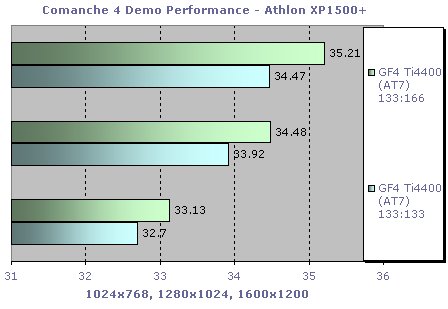
As we can see, giving the processor a little more breathing space in async mode gives rise to slightly bigger scores (~2% across the board). Even though the test resolution varies and should make the card work harder at high resolution, we are massively CPU limited here so the results aren't exciting. AT7 does well here with good performance given the host processor.
With the benchmarks out of the way and the shouting over, lets draw some conclusions on the performance.









